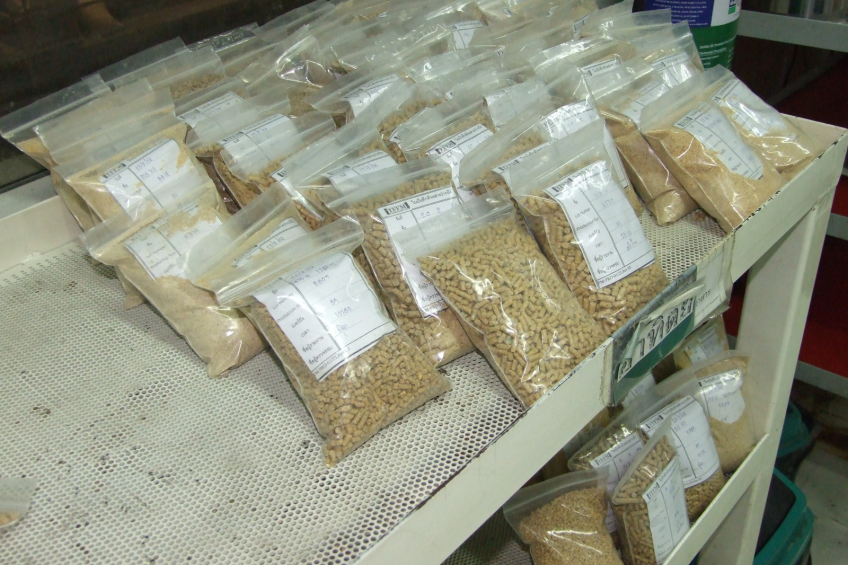Pellet size and its impact on pig performance

Does the physical shape of pig feed affect the health situation, well-being and ultimately ?performance of pigs? Yes, explains Dr Joseph Kamphues. What the effects can be even depends on the age and type of pig.
By Stuart Lumb, on the basis of a presentation by Dr Joseph Kamphues, University of Veterinary Medicine, Hanover, Germany
There are many factors which affect the form in which feed is given to pigs. A feed manufacturer has to think very carefully about how feeds are produced, in terms of the physical form it takes. A compounder wants minimum wear and tear on his machinery but the type of feed that meets his demands might not be ideal as far as the pig’s digestive tract is concerned.
Physical form
Hammer milling is most commonly used to break down raw materials. Roller milling produces coarser particles. When mixing is followed by pelleting there is further impact on particle size as pelleting acts as a secondary grinding process.
Impact on pig health
It’s a widely held view that finely ground diets are linked closely with gastric ulcers. It appears that the prevalence and intensity of gastric lesions increase markedly when the medium particle size is lower than 500 μm, especially with pigs fed pelleted diets. Based on feed analyses it was summarised that diets with more than 35-40% (mass of the fraction <0.2mm) might increase the risks of gastric ulcers developing.
Then again, gastric ulcers can be found in spite of adequate particle size in the diet where, for example, the automatic feeding equipment has broken down resulting in pigs not receiving feed for a number of hours. Seemingly stress is the problem. Furthermore, pigs housed on straw are affected to a lesser degree by gastric ulcers despite being fed finely ground-pelleted diets.
The physical form of the diet can have an effect on the gastro-intestinal flora. In young pigs, coarser unpelleted feed favoured the lactobacilli and further lactic acid producing bacteria when compared to pigs of a similar age fed the same diet, but which was finely ground and pelleted.
Diet form has an effect on the stomach wall and also the pancreas, with coarser diets increasing the mass of the stomach wall and the pancreas.
Physical form and Salmonella
For more than 20 years it has been well established that the physical form of the diet has an impact on Salmonella in pig production. “One explanation,” suggested Kamphues, “is that due to coarse grinding, higher amounts of starch enter the large intestine and result in a stimulated production of butyric, proprionic and lactic acid. These changes in SCFA production should reduce the invasion capacity of Salmonella, resulting in a forced excretion and lower translocation of these zoonotic pathogens.”
Physical form and performance
The main reason for grinding dietary ingredients is for better digestibility plus finer grinding benefits the pelleting process and pellet stability. As far as pellet production is concerned, this process uses up a considerable amount of energy. Energy costs are ever rising and a critical re-evaluation of the intensity of grinding has been carried out by the industry.
Pelleting of course reduces waste when compared to pigs that are fed meal. A special scenario relates to piglet creep feeds, where giving this as a very small pellet encourages the baby pig to start eating solids, when sow milk is a more natural, more attractive and easily obtained alternative.
An employee working at a pellet press in a feed mill.
Physical form and well-being
With sows during pregnancy and especially as farrowing approaches, sometimes the faeces are hard, firm and dry. Whenever things are static in the GI tract there is a risk of endotoxins being absorbed from the alimentary tract, increasing the risk of periparturient disorders. Studies have been carried out whereby diets were produced comprising the same ingredients but differing in the degree of grind, ie coarse to fine. Pregnant sows fed diets which were coarser had faeces which had a higher water content, i.e. were softer.
Conclusions
- Ingredients, milling technology and further compaction technologies (pelleting) markedly influence the percentages of particles of different size contained within a diet;
- The physical form of the diet has a significant effect on the anatomical development of the stomach wall and of the pancreas i.e. coarse diets lead to increased weights;
- Coarse mash diets (wheat/ barley based) did not result in reduced digestibility rates in comparison to pelleted feeds based on finely ground ingredients;
- Regarding daily gain, coarse diets result in similar rates but the FCR might be negatively affected;
- When coarse diets are fed to pigs higher amounts of starch will enter the large intestine and be fermented, acting like prebiotics;
- Coarse mash diets are recommended to be fed on units where there is a challenge due to increased Salmonella prevalence;
- With respect to diets for pregnant sows, coarse mash diets give favourable effects regarding defecation and faeces composition, and also regarding periparturient disorders.
This is a summary of a presentation at the 6th European Symposium of Porcine Health held in Sorrento, Italy, in May 2014.
[Source: Pig Progress magazine Vol 30 nr 7, 2014]











